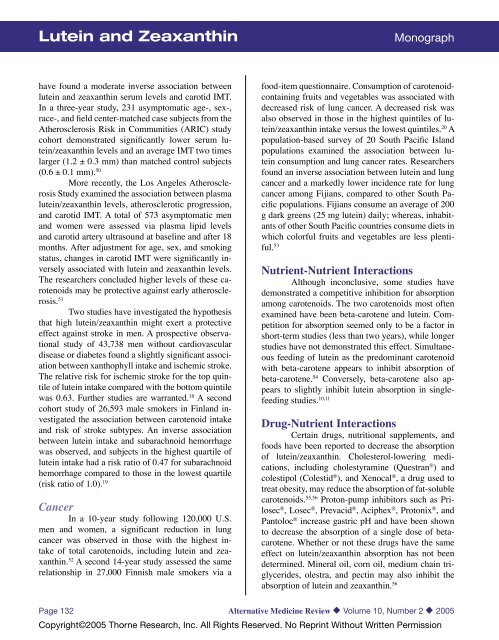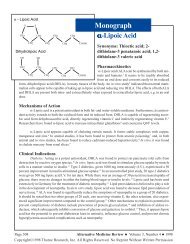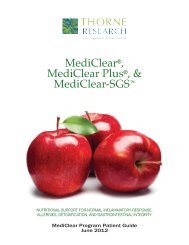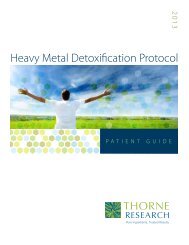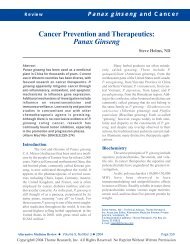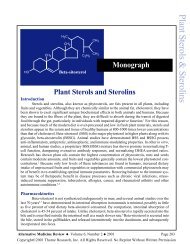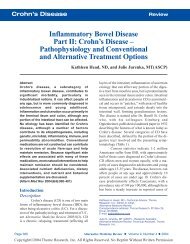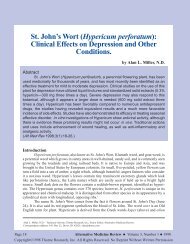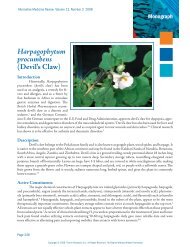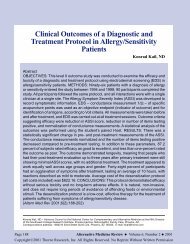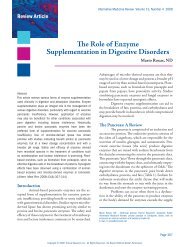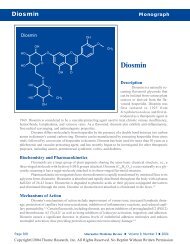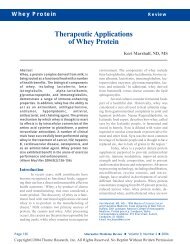Lutein and Zeaxanthin - Thorne Research
Lutein and Zeaxanthin - Thorne Research
Lutein and Zeaxanthin - Thorne Research
You also want an ePaper? Increase the reach of your titles
YUMPU automatically turns print PDFs into web optimized ePapers that Google loves.
<strong>Lutein</strong> <strong>and</strong> <strong>Zeaxanthin</strong><br />
Monograph<br />
have found a moderate inverse association between<br />
lutein <strong>and</strong> zeaxanthin serum levels <strong>and</strong> carotid IMT.<br />
In a three-year study, 231 asymptomatic age-, sex-,<br />
race-, <strong>and</strong> field center-matched case subjects from the<br />
Atherosclerosis Risk in Communities (ARIC) study<br />
cohort demonstrated significantly lower serum lutein/zeaxanthin<br />
levels <strong>and</strong> an average IMT two times<br />
larger (1.2 ± 0.3 mm) than matched control subjects<br />
(0.6 ± 0.1 mm). 50<br />
More recently, the Los Angeles Atherosclerosis<br />
Study examined the association between plasma<br />
lutein/zeaxanthin levels, atherosclerotic progression,<br />
<strong>and</strong> carotid IMT. A total of 573 asymptomatic men<br />
<strong>and</strong> women were assessed via plasma lipid levels<br />
<strong>and</strong> carotid artery ultrasound at baseline <strong>and</strong> after 18<br />
months. After adjustment for age, sex, <strong>and</strong> smoking<br />
status, changes in carotid IMT were significantly inversely<br />
associated with lutein <strong>and</strong> zeaxanthin levels.<br />
The researchers concluded higher levels of these carotenoids<br />
may be protective against early atherosclerosis.<br />
51<br />
Two studies have investigated the hypothesis<br />
that high lutein/zeaxanthin might exert a protective<br />
effect against stroke in men. A prospective observational<br />
study of 43,738 men without cardiovascular<br />
disease or diabetes found a slightly significant association<br />
between xanthophyll intake <strong>and</strong> ischemic stroke.<br />
The relative risk for ischemic stroke for the top quintile<br />
of lutein intake compared with the bottom quintile<br />
was 0.63. Further studies are warranted. 18 A second<br />
cohort study of 26,593 male smokers in Finl<strong>and</strong> investigated<br />
the association between carotenoid intake<br />
<strong>and</strong> risk of stroke subtypes. An inverse association<br />
between lutein intake <strong>and</strong> subarachnoid hemorrhage<br />
was observed, <strong>and</strong> subjects in the highest quartile of<br />
lutein intake had a risk ratio of 0.47 for subarachnoid<br />
hemorrhage compared to those in the lowest quartile<br />
(risk ratio of 1.0). 19<br />
Cancer<br />
In a 10-year study following 120,000 U.S.<br />
men <strong>and</strong> women, a significant reduction in lung<br />
cancer was observed in those with the highest intake<br />
of total carotenoids, including lutein <strong>and</strong> zeaxanthin.<br />
52 A second 14-year study assessed the same<br />
relationship in 27,000 Finnish male smokers via a<br />
food-item questionnaire. Consumption of carotenoidcontaining<br />
fruits <strong>and</strong> vegetables was associated with<br />
decreased risk of lung cancer. A decreased risk was<br />
also observed in those in the highest quintiles of lutein/zeaxanthin<br />
intake versus the lowest quintiles. 20 A<br />
population-based survey of 20 South Pacific Isl<strong>and</strong><br />
populations examined the association between lutein<br />
consumption <strong>and</strong> lung cancer rates. <strong>Research</strong>ers<br />
found an inverse association between lutein <strong>and</strong> lung<br />
cancer <strong>and</strong> a markedly lower incidence rate for lung<br />
cancer among Fijians, compared to other South Pacific<br />
populations. Fijians consume an average of 200<br />
g dark greens (25 mg lutein) daily; whereas, inhabitants<br />
of other South Pacific countries consume diets in<br />
which colorful fruits <strong>and</strong> vegetables are less plentiful.<br />
53<br />
Nutrient-Nutrient Interactions<br />
Although inconclusive, some studies have<br />
demonstrated a competitive inhibition for absorption<br />
among carotenoids. The two carotenoids most often<br />
examined have been beta-carotene <strong>and</strong> lutein. Competition<br />
for absorption seemed only to be a factor in<br />
short-term studies (less than two years), while longer<br />
studies have not demonstrated this effect. Simultaneous<br />
feeding of lutein as the predominant carotenoid<br />
with beta-carotene appears to inhibit absorption of<br />
beta-carotene. 54 Conversely, beta-carotene also appears<br />
to slightly inhibit lutein absorption in singlefeeding<br />
studies. 10,11<br />
Drug-Nutrient Interactions<br />
Certain drugs, nutritional supplements, <strong>and</strong><br />
foods have been reported to decrease the absorption<br />
of lutein/zeaxanthin. Cholesterol-lowering medications,<br />
including cholestyramine (Questran ® ) <strong>and</strong><br />
colestipol (Colestid ® ), <strong>and</strong> Xenocal ® , a drug used to<br />
treat obesity, may reduce the absorption of fat-soluble<br />
carotenoids. 55,56 Proton-pump inhibitors such as Prilosec<br />
® , Losec ® , Prevacid ® , Aciphex ® , Protonix ® , <strong>and</strong><br />
Pantoloc ® increase gastric pH <strong>and</strong> have been shown<br />
to decrease the absorption of a single dose of betacarotene.<br />
Whether or not these drugs have the same<br />
effect on lutein/zeaxanthin absorption has not been<br />
determined. Mineral oil, corn oil, medium chain triglycerides,<br />
olestra, <strong>and</strong> pectin may also inhibit the<br />
absorption of lutein <strong>and</strong> zeaxanthin. 56<br />
Page 132 Alternative Medicine Review ◆ Volume 10, Number 2 ◆ 2005<br />
Copyright©2005 <strong>Thorne</strong> <strong>Research</strong>, Inc. All Rights Reserved. No Reprint Without Written Permission


